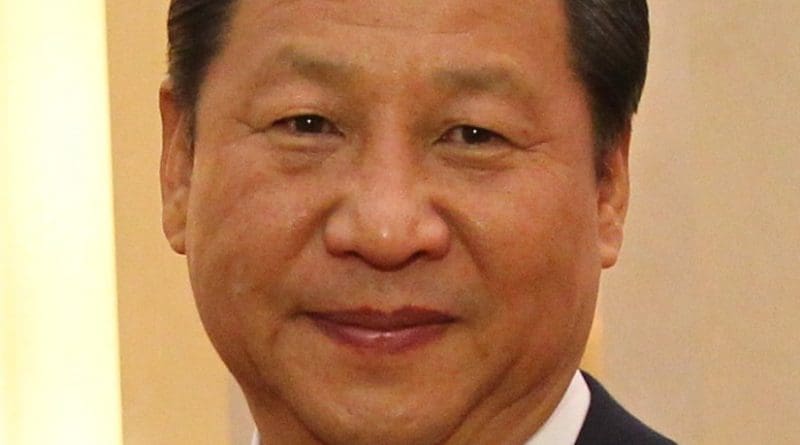China’s Military Cut: Xi’s Attempts At Control – Analysis
By Divya Kumar Soti*
During the September 3 celebrations marking China’s victory over Japan in the Second World War, President Xi Jinping announced a big military cut scheduled to be completed by 2017. The proposed cuts will lay off 300,000 People’s Liberation Army (PLA) soldiers bringing down its strength by around 13%. Chinese State Media has largely applauded the announcement as a part of military reform and modernization process initiated by Xi after coming into the office.
Xi’s plans to revamp and reorient the PLA have been the most robust ones after Deng Xiaoping’s path breaking military reforms in 1980s and may culminate into the reorganization of PLA command and control structure in the same streak. The first phase of this reform process initiated by Xi involved rooting out corrupt elements from the PLA. The latest troop cut is a step to prepare base for the next phase of advanced reforms.
Even after this cut, PLA will still be the largest military force in the world with around two million personnel. Since Mao’s times, Communist Party of China (CPC) maintained exceptionally high troop levels for various domestic and historic reasons. PLA was used as a military organ of the CPC to maintain the single party system with political education being part of its training regime. Within two years of CPC grabbing power, China got embroiled in the Korean War against UN forces led by US which saw heavy PLA causalities in the range of 200,000 to 400,000 (varying estimates). Maintaining firm grip over a vast country including newly acquired territories like Tibet, worries about Japanese resurgence, threat perception from US and later also from USSR and a huge border dispute with India were some of the reasons for this exceptionally high troop levels.
However, CPC leadership has never been blind to the changing strategic dynamics, military rationale and domestic political circumstances. Xi’s troop cut announcement is latest in the series which go back to Mao’s reign. When CPC came to power, PLA had strength of around 5 million with an equally strong irregular militia. By 1953, demobilization ordered by Mao would bring down the PLA strength to 2.8 million. In 1985, Deng cut troop level by another 1,000,000 though he created an equally strong paramilitary force, the Armed Police. Jiang Zemin cut another 200,000 in 1997 and 200,000 again in 2002.
All these troop cuts were as much connected with domestic political situation as with external threat perceptions. For instance, Mao demobilized such large numbers because of economic as well as because they were not well trained and politically well-briefed. The 1985 cut by Deng was part of implementation of his firm conviction about the need to disengage the PLA from domestic politics and to erase the influences of Cultural Revolution on the years following it. By 1985, China had reasonably good relations with US and Party rule witnessed no major challenge by opening-up of the Chinese economy.
By 1997, Soviet collapse had stabilized; US and China had achieved substantial economic interdependence and no major backlash of Tiananmen Square repression had emerged. 2003 cut followed successful brutal crackdown upon Qigong cults in China which many consider was more horrendous and widespread than Tiananmen Square incidents.
So, what is the rationale underlying President Xi’s Victory Day troop cut announcement? On the external front, Xi is sending out signals of peaceful intention and trying to allay fears of neighbors emanating from mammoth Chinese claims both on land and sea. Militarily, it is a step to reorient PLA for greater naval and aerial roles. China’s disputes with Vietnam, Philippines as well as disputes with Japan do not require any major ground troop deployments. An invasion of Taiwan, if it ever comes, is going to be primarily naval in nature. Only China’s territorial disputes with India requires major ground troop deployment which it will be easily able to sustain and boost it through aerial support. Victory day cut comes within months of India cutting down to half the proposed size of a new Mountain Corps to be deployed in Arunachal Pradesh.
On domestic front, all the troop cuts from Deng’s times signify that Communist Party is feeling in control and does not anticipate any major instability and challenge to its authority. 1997 and 2003 cuts were announced after major challenges to CPC policies, namely, Tiananmen Square agitations and Qigong protests, were effectively suppressed. Between 2003 and 2015, China has passed through the first phase of worldwide Social Media Revolution and CPC had devised ways to watch, censor and manipulate the Social media and internet in general. The social media was anticipated by many to be able to sow seeds of democratic movement in China but so far that is not visible on large scale. Communist Party leadership also sees an end to Tibet issue after the Dalai Lama, while the Islamist insurgency in Xinjiang has so far failed to develop beyond sporadic knife attacks and arson incidents.
A South China Morning Post report talked of another cut in armed police, the main internal security paramilitary force, which would lay off more than 400,000 personnel by 2017. If it does come, it will further testify about Xi’s confidence on domestic front.
Soldiers laid off in the past have often joined the protests against the Chinese government. Recently, some write-ups in PLA Daily have expressed surprise over the manner in which cut was announced. It will be interesting to see how this latest cut plays out on the domestic front as it follows a major anti-corruption drive in PLA which many see as Xi’s larger attempts to stamp out adversarial elements from the PLA and CPC structures.
*Divya Kumar Soti is a national security and strategic affairs analyst. He can be reached at [email protected]

